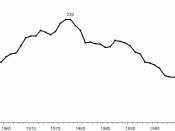Welfare in Society
While some families in the United Sates enjoy large incomes and can live very comfortably, others experience severe economic strain on a daily basis and rely on the welfare system to survive. Although family poverty is witnessed throughout the country, there is one population that suffers the highest percentage of poverty: single-mother households. In 2001, 6.81 million or 9.2% of U.S. families were identified as living below the poverty level, and of these families, 3.47 million, or 51% were headed by a single mother (U.S. Census Bureau). The statistics did not stay constant but worsened by 2002, with 200,000 more single mothers falling below the poverty level. With the new Temporary Assistance for Needy Families (TANF) welfare program implemented in 1997 by the Clinton Administration, there has been increasing controversy as to whether this new program has improved or worsened the poverty situation in the country. It is important to analyze the statistics of both the proponents and opponents of this new policy to determine who has been affected negatively or positively and the implications that has for our society.
In examining the current welfare system, statistics have shown that while a welfare system is needed for society, the current system is ineffective in aiding those in need.
A common negative aspect of welfare is that people who are not motivated tend to take the easy way out while other citizens that struggle to make a living, end up paying out of their tax money to support the welfare system. While food stamps are widely acknowledged, most cases are equivalent to cash in their impact on poor spending habits; they are administered quite differently than cash transfers. The Food Stamp Program (FSP) is the largest public assistance program that has uniform national standards. Opponents of the program...



good
good
0 out of 0 people found this comment useful.